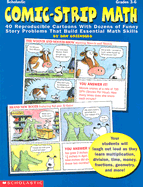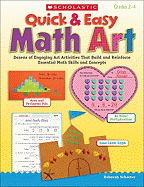Art Books to Teach Multiplication
Comic-Strip Math: Problem Solving: 80 Reproducible Cartoons with Dozens and Dozens of Story Problems That Motivate Students and Build Essential Math Skills by Dan Greenberg. (2010). Scholastic Teaching Resources (0545195713). Gr. 3 - 6.
This is such a brilliant idea - what a fantastic way to blend art, math, reading,and writing. Using comics to explore math encourages students to use their visual, verbal, spatial, and logic skills in interpreting situations. While most of the multiplication exercises in the book incorporate multi-step problems (some of which also ask children to take the next step into division), there is a nice section in the book with lots of fun activities for them to solve (p. 12 - 19). Each lesson features a comic at the top, which concludes with a "figure it out" question, and then the follow-up questions listed below take on a more-familiar worksheet format. There are "super challenges" at the bottom of each page to help students extend what they've learned and some encourage them to create their own pictures, diagrams, charts and models. I would suggest setting up a math/art center for students to make their own multiplication comic strips. You could use graph paper to help them better design the more traditional story-board layout, or take larger paper and fold it to create frames for students to draw in. Encouraging them to think about and ask multiplication problems through art and humor and then asking them to share them with classmates could be incredibly fun for everyone. (Greenberg also has another related book that has other mini-story problems).
Fun-Flap Facts: Multiplication by Danielle Blood. (2004). Scholastic Teaching Resources (0439365449). Gr. 2 - 4.
The subtitle to this book says it all: "22 Super-Motivating, Self-Checking Manipulatives That Help All Kids Practice and Really Learn The Times Table From 1 - 12." This is an incredibly simple way to use art to teach multiplication (especially for those educators who think they're really not all that artistic). All kids love "cootie catchers," but they may not realize that the form comes from origami art. What child wouldn't have a blast making origami fun-flaps? You could call them "multiplication catchers" or maybe even "multiplication munchers" (they do look a little like mouths), and the each of the fun flaps has cute little illustrations that kids can color and enjoy. There are fun flaps for each number 1 through 12 and there are even fun flaps for review. The author includes directions on how to teach children how to fold their paper and offers up self-checking quizzes to reinforce the lessons. (By the way, if you like this idea, Blood also has a fun-flaps facts book for teaching fractions and decimals).
Math Art: Hands-On Math Activities for Grades 2, 3, and 4 by Zachary J. Brewer. (2010). Create Space (1453636439). Gr. 2 - 4.
This helpful book shows you how to successfully integrate arts into any elementary math curriculum: "by blending the subjects of mathematics and art, Math Art is capable of motivating students, decreasing classroom discipline problems, increasing student retention of knowledge, and assisting the instruction of visual learners, kinesthetic learners, and English Language Learners." Each of the math activities ultimately result in an aesthetically-pleasing project that reinforces a basic math concept. Inside are two great projects to help teach multiplication to third grade students: a project about multiples (p. 14 - 17), which demonstrates how to skip count and how to tell the difference between common and uncommon multiples, and another that shows how to represent multiplication facts as arrays (p. 26 - 27). All the lessons list teaching objectives, what materials are required, full project descriptions, and black line masters of reproducible assessment sheets (which require students to explain their mathematical thinking in writing) - and all are aligned with NCTM standards in mind.
MathART Projects and Activities by Carolyn Ford Brunetto. (1999). Scholastic Teaching Resources (0590963716). Gr. 3 - 5.
This book is full of good ways to connect math to simple art projects, and inside there are two very fun multiplication projects: multiplication constellations (p. 38 -41), and my favorite idea, multiplication houses to reinforce basic multiplication facts for numbers 1 to 12 (p. 40 - 41). Using the template, students can create their houses - or if you are more artistically inclined, you can encourage them to create their own houses (or skyscrapers, or other buildings). For example, if a student creates the house of nine, the number 9 would be written on the door. The numbers 1 to 12 would be written on the house's twelve windows. When you open the window to any given number, you see the product of nine and that number revealed. Creating these houses for kids to use as lesson guides would be very enjoyable, and if you made large ones for your classroom, you could create your own Multiplication Neighborhood that your students could look at for review.
This book is full of good ways to connect math to simple art projects, and inside there are two very fun multiplication projects: multiplication constellations (p. 38 -41), and my favorite idea, multiplication houses to reinforce basic multiplication facts for numbers 1 to 12 (p. 40 - 41). Using the template, students can create their houses - or if you are more artistically inclined, you can encourage them to create their own houses (or skyscrapers, or other buildings). For example, if a student creates the house of nine, the number 9 would be written on the door. The numbers 1 to 12 would be written on the house's twelve windows. When you open the window to any given number, you see the product of nine and that number revealed. Creating these houses for kids to use as lesson guides would be very enjoyable, and if you made large ones for your classroom, you could create your own Multiplication Neighborhood that your students could look at for review.
Quick and Easy Math Art: Dozens of Engaging Art Activities That Build and Reinforce Essential Math Skills and Concepts by Deborah Schecter. (2011). Scholastic Teaching Resources (0439199425). Gr. 2 - 4.
Here is another great art-math resource offered by Scholastic, chock full of great, inexpensive, and simple projects that anyone can do. There are a number of very cute multiplication activities (p. 14 - 22): Be Mine! Multiplication (which you can see in color on the cover of the book), Multiplication Menageries, Fall Factor Trees, and Teeny-Tiny Times Table Books. I appreciate that the author makes it clear that educators should test out these projects before introducing them to the class - as any art teacher can tell you, figuring out how to do them on your own first can help you determine exactly how you need to model instruction, what steps are important to emphasize, and will help you figure out how complicated (and possibly time consuming) it is going to be. Many of these multiplication projects would be suitable to use at math centers.
Useful Websites
Math Art: Hands-On Math Activities for Grades 2, 3, and 4: This is the web page for Zachary Brewer's book. Here you will find pictures and descriptions of various projects throughout the book, including his lesson on common multiples and his lesson on multiplication arrays. He also includes a link if you are interested in purchasing the book.
Math Art: Hands-On Math Activities for Grades 2, 3, and 4: This is the web page for Zachary Brewer's book. Here you will find pictures and descriptions of various projects throughout the book, including his lesson on common multiples and his lesson on multiplication arrays. He also includes a link if you are interested in purchasing the book.
Math-Comic-Strips.com: It might just be a stretch to find this book, but Math Comics Strips released a comic called The Innovative Doctor Knowledge which features a cool math-problem-solving super hero. For students who love the idea of creating their own math comic books, this might be fun to check out. Even if you can't find it, perhaps your students could create their own math superheroes: The Masked Multiplier? The Times Table Terror super villain?
National Gallery of Art: NGA Kids: While this is just a wonderful arts site for kids to create their own artistic compositions, you can bookmark this at your classroom computer center and invite students to create online works that demonstrate multiplication concepts. Basic multiplication can be expressed through art through image repetition, and here kids can try all kinds of cool programs: BRUSHTER (an interactive painting machine); NGAkids Photo Op (an introduction to digital photography and image editing); the Collage Machine; Mobile Maker; FLOW (a remarkable interactive motion painting program); and Wallovers (which uses a 6 x 4 grid for students to create symmetrical compositions and can reinforce the interrelatedness between multiplication and addition). Students can create the multiplication masterpieces and then write out what kinds of images are multiplied in their work (and express them as equations). (If students want to print their work, I would suggest that you have a good color printer in your classroom)
Origami Multiplication Flash Cards: If cootie catchers aren't your thing, you may want to make these basic origami shapes and encourage your students to do the same. These are found on Rick Morris's New Management website, and you can use them with his multiplication triangle tests (downloadable as a PDF file at the bottom).
String Art and Math: A Project in Multiplication: While I normally associate string art with bad 1970s home decor, I think this is a really interesting way to play artfully with multiplication. Instead of using nails to create the string art, students will have to be advanced enough to know how to use embroidery thread and needles to pull the thread through cardstock printed with the design template. This could be a good art/math center activity for those students with strong fine motor skills, and could produce very colorful work for display in the classroom. (The sample worksheet is downloadable as a PDF file at the bottom of the page)
Teacher Information
Virginia Standard of Learning
Teacher Information
Virginia Standard of Learning
3.5: The student will recall multiplication facts through the twelves table.
Background information from the Curriculum Framework
- The development of computational fluency relies on quick access to number facts.
- A certain amount of practice is necessary to develop proficiency with computational strategies; however, the practice must be motivating and systematic if students are to develop fluency in computation, whether mental, with manipulative materials, or with paper and pencil.
- In order to develop and use strategies to learn the multiplication facts through the twelves table, students should use concrete materials, the hundreds chart, and mental mathematics.






No comments:
Post a Comment